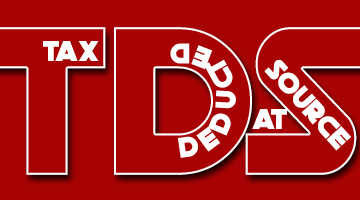Whether when Sec 200A(1) allows filing of TDS correction, is it fair for Revenue to limit PAN correction upto two alphabets & two numeric characters in case of mechanical error or oversight - NO: HC
By TIOL News Service
AHMEDABAD, JULY 17, 2017: THE issue before the Bench - Whether when the provisions of Sec 200A(1) allow filing of TDS correction statement, is it fair for the Revenue to limit the PAN correction upto two alphabets and two numeric characters in case of mechanical error or oversight. NO is the verdict.
Facts of the case
The assessee is engaged in the business of advertisement. In the course of business, the assessee deducted tax at source at 2%. One of the recipients of such payments happened to be one M/s. Star (India) Pvt. Ltd. During the second and third quarters of the financial year 2010-2011, the assessee had made deductions at the rate of 2% made to M/s. Star (India) Pvt. Ltd. in terms of section 194C. However, on account of an inadvertent error while filing TDS returns for the said second and third quarters, the PAN of the deductee M/s. Star (India) Pvt. Ltd. was wrongly mentioned in the prescribed format provided in Form No. 26Q. The assessee had not immediately noticed such error. During the course of processing this declaration, the Revenue found that the PAN indicated by the assessee of the deductee in the declaration did not match with the actual PAN of M/s. Star (India) Pvt. Ltd.. The authority therefore, proceeded on the basis that the PAN provided to the deductor did not belong to the deductee and, therefore, in terms of sub-section (6) of section 206AA of the Act, it would have the effect as if the deductee has not furnished the PAN to the deductor and the effect of provisions of sub-section (1) of section 206AA would follow. We may notice that in terms of sub-section (1) of section 206AA, when the person entitled to receive any sum on which the tax is deductible under Chapter XVIIB fails to furnish the PAN, the tax would be deducted at a higher rate, in the present case at the rate of 20%. The authority proceeded on the footing that the assessee which was required to deduct tax at the rate of 20% had deducted the same at the rate of 2% and after adjusting such tax deducted, raised demand of the remaining tax. The Revenue also called for explanation for the short deduction of tax at source of a sum of Rs.2.04 crores for the financial year 2010-2011. Along with the said communication, the authority also provided the full working of the mismatch of the PAN indicated by the assessee in the declaration made before the authority and the correct PAN of the recipient M/s. Star (India) Pvt. Ltd.
Having got to know about the errors the assessee tried to correct its PAN declaration. However, the online system of the department did not permit the correction. According to the assessee, this was so because the system was programmed to permit correction only in case four digits/characters are to be changed and no more. In case of the assessee, entire PAN number of the recipient of the payment was wrongly fed. This required substitution of the entire number which the online system of the department would not permit. In this background, the assessee preferred the writ route.
Having heard the parties, the Bench held that,
++ the Revenue has stated that it does not rule out the possibility of genuine errors in feeding PAN numbers of the deductees. However, the online computerised system of the department permits corrections limited to extent of four characters, two numeric and two alphabets and no more. A presumption is therefore, raised that a genuine typographical error would not lead to mistakes beyond two characters each. Large volume of transactions and TDS entries and the requirement of completion of timely processing of such entries are cited as reasons to limit the scope of corrections;
++ the short question is - Did the department commit an error in not allowing the assessee to correct the declaration of tax deducted at source? From the materials on record, it can be easily gathered that Chapter XVIIB of the Act contains important statutory provisions for deduction and collection of tax at source. Various provisions have been made enjoining duty on the payer to deduct tax at source, at the time of making certain payments to the payee. Such tax would have to be within the prescribed time deposited with the Government Revenue and a declaration of such tax deduction would have to be made in the prescribed format. The stand of the Revenue that it is only when such tax is not only deducted but properly declared before the authorities that the same can be processed and ultimate benefit can be given to the deductee, also can be easily appreciated. In this context, requirement of giving correct PAN number of the deductee is a statutory responsibility;
++ however, neither the statute nor the department completely rules out the possibility of genuine and bona fide typographical or even mechanical errors. It is in this context, section 200A refers to a statement of tax deducted at source or a correction statement. We may recall sub-section (3) of section 200 refers to requirement of filing a statement of tax deducted at source. This provision though does not refer to any mechanism for correction of such a statement, sub-section (1) of section 200A specifically refers to a statement of tax deduction at source or a correction statement thus, clearly leaving the possibility of correcting a declaration once made by the assessee. Even the department does not dispute that there is absolutely no mechanism permitting such corrections. The department however, points out that all the forms are to be generated online and corrections can also be therefore, made only online. It is also pointed out and in our opinion with justification that looking to the large number of such statements and entries in such statements, it would be impossible to process individual claims of corrections, whether they are based on bona fide mistakes or otherwise. We have noticed that even as per the department, the online system permits corrections limited to two alphabetical and two numerical errors in the PAN number;
++ having thus recognised the need and possibility for correction of statement of deduction of tax at source, the question is, was it open for the department to limit such corrections to two alphabets and two numeric characters when it came to indicating incorrect PAN number? Such limited permission to correct is sought to be justified on two grounds. One is that if the error is genuine and bona fide in feeding the PAN number, it is unlikely that a typographical error would travel beyond such characters and the second is that looking to the millions of statements and entries being filed by the assessees across the country, it would open flood gates, if corrections are permitted without any limit.
17. In our view, once the department recognises the possibility of errors and also makes provisions for making corrections, it would be wholly illogical to limit such corrections on arithmatical working out of only two alphabets or two numerics being found incorrect requiring change. Error in feeding an entry or a number may have multiple origins from typographical error of Data Entry Operation to mechanical failures or through pure oversight referring to one column of PAN instead of another while filling up and uploading the statement. It is not necessary nor possible for us to envisage different situations under which such errors could crop up and it need not necessarily be confined to limited figures on the letters of the PAN being incorrect;
++ it is entirely one thing to suggest that the department would not accept any change once certain entries are uploaded or at any rate no change would be permissible beyond a certain date. However, it is entirely another thing to suggest that the corrections may be permitted but should be limited to a number of characters where correction is needed. We are not unsympathetic to the department's view that late corrections can derail assessments of the deductees. If the legislature therefore, had laid down that no corrections would be permitted or the department had provided that no correction would be permitted beyond a particular period, we could have examined the issue in different light. However, that is not the present situation. In the present case, as noted, section 200A itself refers to correction statement of tax deducted at source. The intimation sent to the assessee of shortfall in deduction of tax also referred to the possibility of correction but limited it to certain characters. In the affidavit in reply also same stand has been taken;
++ some anomalous situations would arise if genuine and bona fide errors are not allowed to be corrected only on the basis that such correction travelled beyond two alphabets and two numeric characters which the system would not accept. As is contended in the present case, the deductee i.e. M/s. Star (India) Pvt. Ltd. has already discharged its full tax liability. If the full effect of the department's decision is allowed, the deductee would not get the benefit of 2% of tax deducted by the assessee and already deposited with the Government. Since the PAN does not match, the deductor would pay additional 18% which though is styled in the name of tax deducted at source, would be additional to what M/s. Star (India) Pvt. Ltd. would have paid by way of tax to the department. Essentially, “the tax deducted at source” would have to be given credit to the payee on whose behalf such tax is being deducted. In the present case, payee having already discharged its tax liability independently, such amount would remain in Government coffers not accounted for anyone's tax liability;
++ we can well imagine the predicament of the department if individual cases were allowed to be brought before the authority requiring examination of genuineness of the errors and justification for allowing corrections. We are therefore, not suggesting that such cases may be dealt with individually on case to case basis. Nevertheless, we cannot uphold the stand of the department that PAN incorrection can be corrected as long as mismatch is upto two alphabets and two numeric characters. This distinction or drawing of a cutoff line cannot be supported by any logic. We do not even find any conscious decision placed before us which can be stated to be the basis of this policy. Affidavit in reply merely refers to the requirement of limiting the correction of such errors, according to which the online system has been programmed. Programming of the online system is merely a mechanical part of the decision. The decision to limit the correction to limited characters is a policy decision which should be based on logical parameters. Had the department in mind the possible interest claims of the deductors in case of delay in processing the refunds, provisions could easily have been made in law either through statute or through delegated legislation, imposing restriction on time upto which corrections can be made or even allowing conditional corrections. Nevertheless, putting the limitation of permitting corrections of only four characters has no rationale relation to the department's anxiety of possible interest liability in case of the deductees.
++ we hold that the decision of department in not permitting the assessee to correct PAN of the deductee in the statement of tax deducted at source was impermissible. In the present case, department shall verify the assessee's claim of actual deduction of tax at the prescribed rate in case of M/s. Star (India) Pvt. Ltd., verify that the PAN sought to be corrected belongs to the said agency and that the tax was actually deposited in case of such deductor. If these questions are answered in favour of the assessee, the department shall not insist on raising higher demand from the assessee of failing to deduct tax at source in terms of sub-section (1) of section 206AA of the Act.
(See 2017-TIOL-1313-HC-AHM-IT)
















